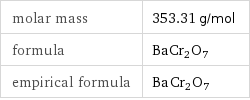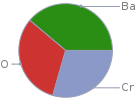Input interpretation

BaCr2O7 (chemical compound)
Basic properties

molar mass | 353.31 g/mol formula | BaCr2O7 empirical formula | Ba_Cr_2O_7
Elemental composition

Find the elemental composition for BaCr2O7 in terms of the atom and mass percents: atom percent = N_i/N_atoms × 100% mass percent = (N_im_i)/m × 100% Plan: • Write the chemical formula and gather atomic masses from the periodic table. • Determine values for N_i, m_i, N_atoms and m using these items. • Finally, compute the percents and check the results. Use the chemical formula to count the number of atoms, N_i, for each element and find the total number of atoms, N_atoms, per molecule: | number of atoms Ba (barium) | 1 Cr (chromium) | 2 O (oxygen) | 7 N_atoms = 1 + 2 + 7 = 10 Divide each N_i by N_atoms to calculate atom fractions. Then use the property that atom fractions must sum to one to check the work: | number of atoms | atom fraction Ba (barium) | 1 | 1/10 Cr (chromium) | 2 | 2/10 O (oxygen) | 7 | 7/10 Check: 1/10 + 2/10 + 7/10 = 1 Compute atom percents using the atom fractions: | number of atoms | atom percent Ba (barium) | 1 | 1/10 × 100% = 10.00% Cr (chromium) | 2 | 2/10 × 100% = 20.0% O (oxygen) | 7 | 7/10 × 100% = 70.0% Look up the atomic mass, m_i, in unified atomic mass units, u, for each element in the periodic table: | number of atoms | atom percent | atomic mass/u Ba (barium) | 1 | 10.00% | 137.327 Cr (chromium) | 2 | 20.0% | 51.9961 O (oxygen) | 7 | 70.0% | 15.999 Multiply N_i by m_i to compute the mass for each element. Then sum those values to compute the molecular mass, m: | number of atoms | atom percent | atomic mass/u | mass/u Ba (barium) | 1 | 10.00% | 137.327 | 1 × 137.327 = 137.327 Cr (chromium) | 2 | 20.0% | 51.9961 | 2 × 51.9961 = 103.9922 O (oxygen) | 7 | 70.0% | 15.999 | 7 × 15.999 = 111.993 m = 137.327 u + 103.9922 u + 111.993 u = 353.3122 u Divide the mass for each element by m to calculate mass fractions. Then use the property that mass fractions must sum to one to check the work: | number of atoms | atom percent | mass fraction Ba (barium) | 1 | 10.00% | 137.327/353.3122 Cr (chromium) | 2 | 20.0% | 103.9922/353.3122 O (oxygen) | 7 | 70.0% | 111.993/353.3122 Check: 137.327/353.3122 + 103.9922/353.3122 + 111.993/353.3122 = 1 Compute mass percents using the mass fractions: Answer: | | | number of atoms | atom percent | mass percent Ba (barium) | 1 | 10.00% | 137.327/353.3122 × 100% = 38.87% Cr (chromium) | 2 | 20.0% | 103.9922/353.3122 × 100% = 29.43% O (oxygen) | 7 | 70.0% | 111.993/353.3122 × 100% = 31.70%
Mass fraction pie chart

Mass fraction pie chart